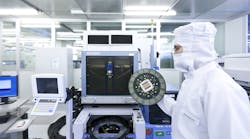In a surprise reshuffling of the market for advanced semiconductors, Infineon Technologies said that it had struck a deal to buy Wolfspeed, a division of Cree making power and radio frequency chips.
Infineon is paying $850 million in cash for Wolfspeed, which fabricates chips for power management and wireless infrastructure. The deal fits the German chipmaker’s mantra of energy efficiency, connectivity, and mobility. In recent years, Infineon has placed bets on the growing markets for renewable energy, autonomous cars, and the Internet of Things.
The deal bolsters Infineon’s power management products, adding to a wide array of sensors, radars, and security chips. While the company supplies chips for things like mobile phones, its largest customer is the automotive industry, which is increasingly buying products that manage car batteries and protect against hackers.
Seeking growth in the market for power semiconductors, Reinhardt Ploss, Infineon’s chief executive, has steered the chipmaker toward silicon chip alternatives. With the deal, Infineon gains access to new compound semiconductors, which are smaller and more energy-efficient than silicon devices. After years of confinement to military electronics, these chips are finding their way into devices like light bulbs and power inverters.
“Joining forces with Wolfspeed represents a unique growth opportunity,” Ploss said in a statement. “This will enable us to create additional value for our customers with the broadest and deepest portfolio of innovative technologies and products in compound semiconductors.”
Wolfspeed is one of the biggest makers of wide bandgap semiconductors, which are capable of handling higher voltages and switching frequencies than silicon chips. Their products are smaller and thinner than conventional chips, cutting energy losses. Its major product is silicon-carbide for power management devices. It has developed a process for layering gallium-nitride material on SiC substrates, forming integrated circuits for wireless applications.
With the deal, Infineon will take control of Wolfspeed’s SiC and GaN devices, in addition to the related chip manufacturing. Those assets include around 550 Wolfspeed employees and 2000 patents and patent applications. Cree will keep manufacturing substrates used in its main lighting business.
The business that Infineon is buying generated revenues of $173 million over the fiscal year ending in March. In 2014, the business that would become Wolfspeed recorded revenues of $120 million. Infineon plans to close the deal by the end of 2016.
Within the next few years, silicon-carbide chips are expected to replace silicon components in electric cars, charging stations, and renewable energy systems, according to Infineon’s Ploss. For example, can be used inside inverters to charge electric cars, manage batteries, and control current flow into drivetrains.
GaN-on-SiC substrates are slowly being used in satellite, telecommunications, and radar systems. Wolfspeed’s manufacturing process can handle high-electron-mobility transistors (HEMTs) on massive microwave integrated circuits, which are used in RF power amplifiers. GaN-on-SiC are extremely efficient at frequency bands up to 80 gigahertz, which could be tapped for 5G wireless networks.
The transaction was announced only months after Cree rebranded the business as Wolfspeed and began working out the details of an initial public offering. The spinout was an attempt for Cree to focus more closely on its main business of LED lighting, which includes chips and bulbs. Chuck Swoboda, chief executive of Cree, said that selling Wolfspeed was also meant to refocus its business operations.
After Cree revealed that Wolfspeed would hold an initial public offering, several companies made offers to buy the business directly, Swoboda said. “After much consideration and due diligence over the past year, we concluded that selling Wolfspeed to Infineon was the best decision for our shareholders, employees and customers,” he said.



